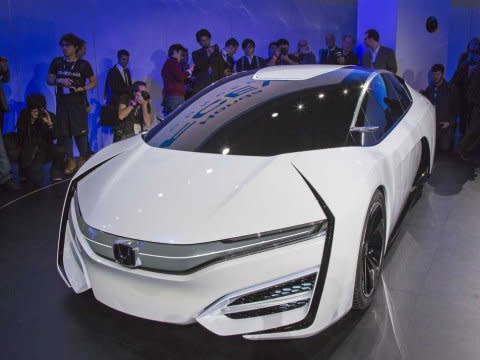Honda Is Working On Hydrogen Technology That Will Generate Power Inside Your Car

At the Los Angeles Auto Show this week, Honda unveiled the FCEV Concept, a futuristic-looking car it says "will feature the world's first application of a fuel-cell powertrain packaged completely in the engine room of the vehicle, allowing for efficiencies in cabin space."
Although fuel cell electric vehicles (FCEV) are rare today, they may have what it takes to be very popular one day.
The benefits of FCEV
FCEVs run on hydrogen gas and oxygen, which an onboard fuel cell stack converts, via a chemical reaction, into electricity.
This version of the electric car offers the same performance and environmental benefits of battery-powered EVs (BEV), as well as the range of conventional cars, as it can be refueled on the go. What's more, the electricity is generated in the car, so a major downside of BEVs — that the power stored in the battery runs out, often rather quickly — is not an issue.
With the proper infrastructure of hydrogen refueling stations (which could be incorporated into present gas stations), FCEVs would have the same "unlimited" range as cars with internal combustion engines.
That means no range anxiety and no long battery charging times, Jack Nerad, executive editorial director and market analyst at Kelley Blue Book, told Business Insider.
No carbon dioxide is pumped into the atmosphere, no noise is made, and the motor delivers better torque than most engine-powered cars, which translates to great acceleration.
The only emission from FCEVs is water vapor, which is a greenhouse gas, but, Nerad says, "not generally regarded as bad as carbon dioxide."
But the technology is vastly underdeveloped and faces serious challenges that could keep it off the roads and out of your driveway for decades to come.
The problems with FCEV
The first hurdle is the actual production of hydrogen.
Pure hydrogen can be industrially derived, but it takes energy. If that energy does not come from renewable sources, then fuel-cell cars are not as clean as they seem.
Meanwhile, Jack Nerad of KBB said, "it's still easy to poke holes in the ground," to extract oil and natural gas. "It's cheap to do that, we know how to do that."
Another challenge is the lack of infrastructure. Gas stations need to invest in the ability to refuel hydrogen tanks before FCEVs become practical, and it's unlikely many will do that while there are so few customers on the road today.
"We're in a chicken-egg situation," according to Nerad.

 Yahoo Autos
Yahoo Autos 
